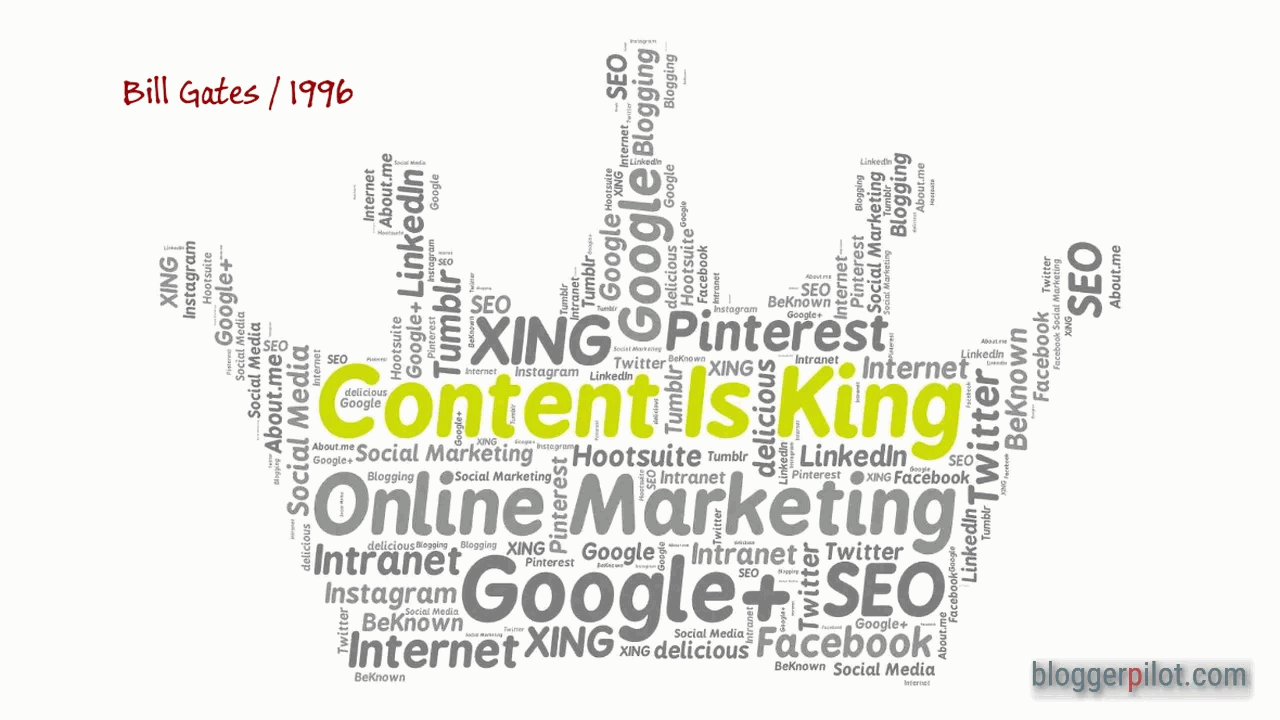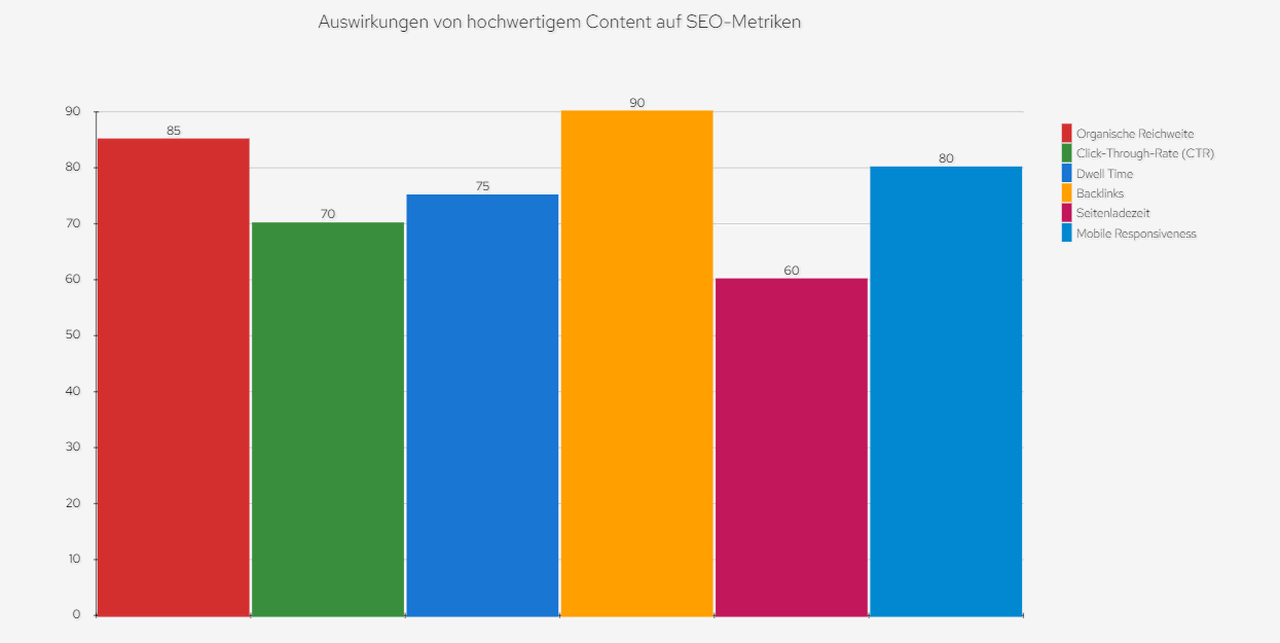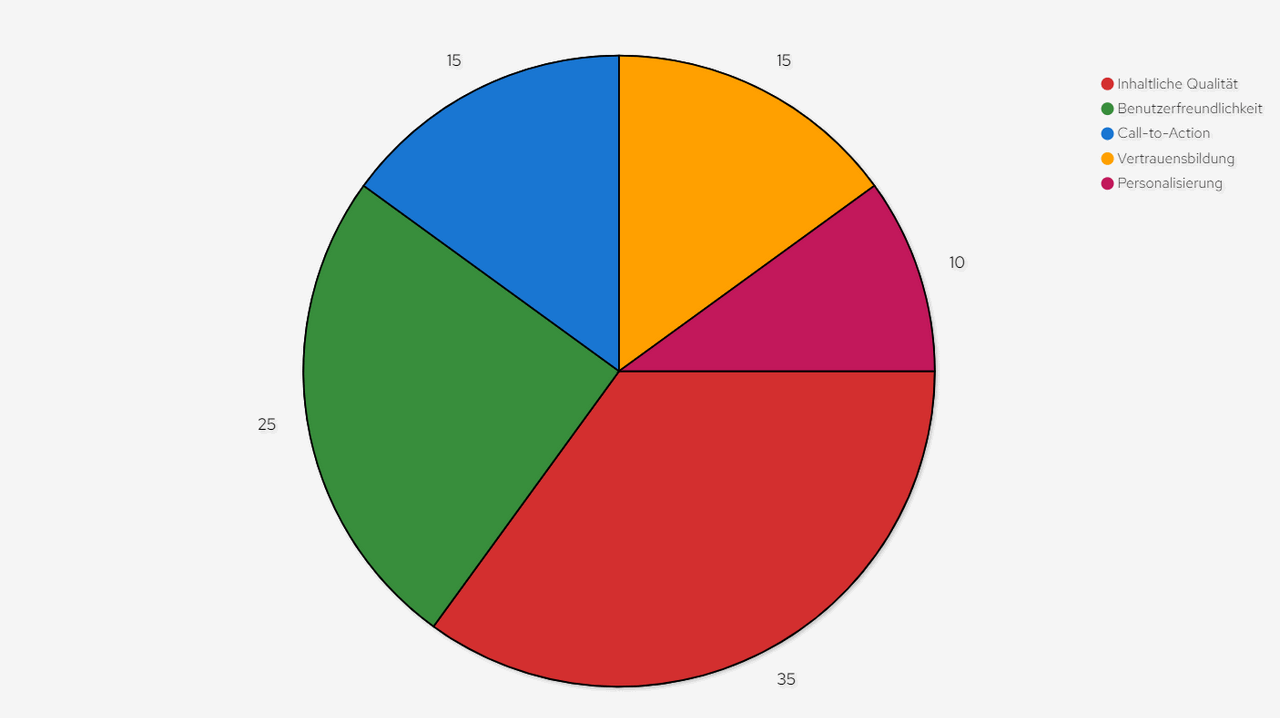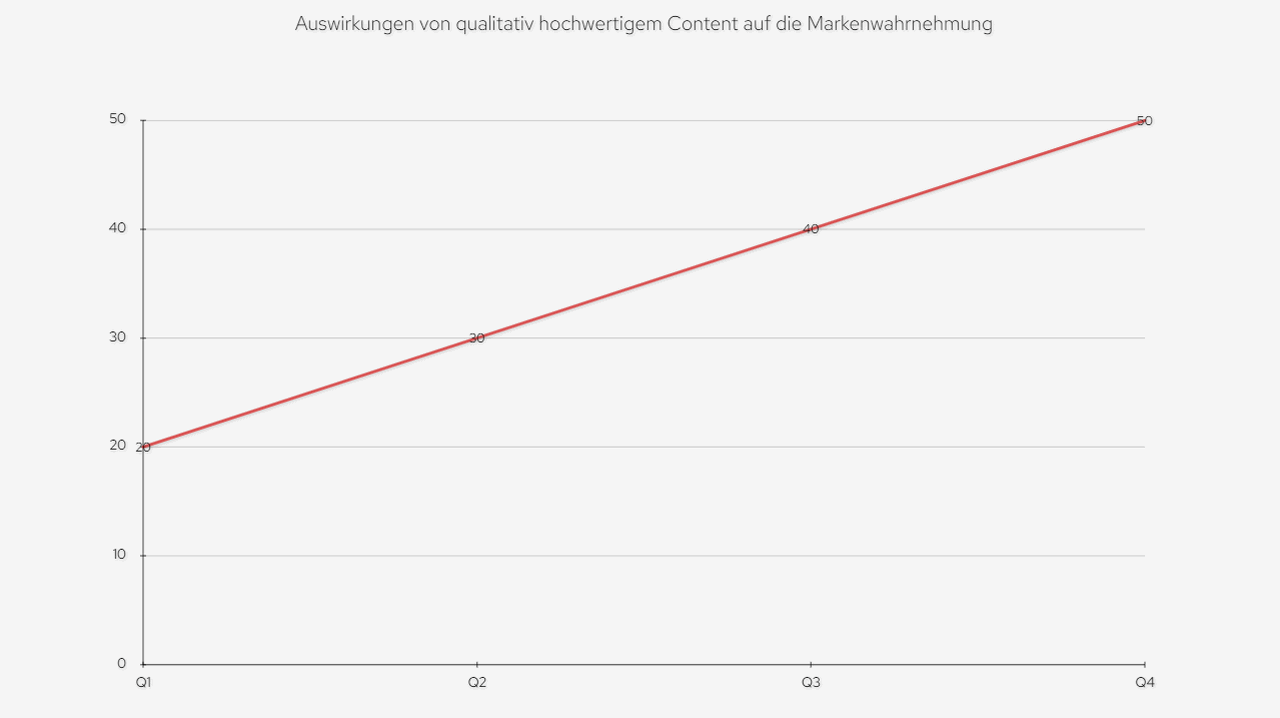Content is King 🥇 Content Creation For bloggers
In today’s digital age, high-quality content is a key component of online marketing. It forms the foundation for successful marketing strategies and significantly influences the visibility, engagement and conversions of a brand or company.
“Content is King” highlights the indispensable role of high-quality content in online marketing. First-class content forms the foundation for successful marketing strategies and significantly influences visibility, engagement and conversion rates of a brand or company.
This article is dedicated to the essential role of top-notch content and highlights various aspects that underline its importance. From the characteristics that make well content, to its impact on search engine optimization, to boosting user engagement and conversions, we will dive deep into the world of premium content. The goal of this article is to present arguments that illustrate why quality, impressive copy is essential in today’s marketing landscape.
What does content mean?
The term “content” refers to the content that is published online. It includes text, images, videos, and other forms of information created by businesses and bloggers to engage their audiences.
Read more: What is content? Content types and content creation.
Content is King

In the digital era, the guiding principle of “content is king” has become the basic tenet of content marketing. But while stunning content is essential, it’s important to understand that “context is god” and “engagement is queen” are equally significant in the modern marketing mix.
WHO COINED “CONTENT IS KING”?
The phrase “content is king” has been around longer than the term content marketing. This section provides a brief overview of the key players and contexts that contributed to the quote, though it is not exhaustive.
- Sumner Redstone, 1994
The late U.S. entrepreneur Sumner Redstone spoke in an interview of new distribution channels through the Internet and the resulting value creation through content. - Bill Gates, 1996
Bill Gates, often cited as the originator of the quote, wrote an article in 1996 predicting that the Internet would serve primarily as a marketplace for content. - Rupert Murdoch, 1999
Rupert Murdoch expanded on the phrase, formulating that content was not only king, but emperor of all things electronic. He attributed the success of his corporation to the quality of its content.
What makes for good content?
In the following table, I have contrasted the most important characteristics of good and bad content:
| Criterion | Good content | Bad content |
|---|---|---|
| Originality | Unique and innovative | Plagiarized or duplicated |
| Relevance | Targeted to a specific audience | Irrelevant or outdated |
| Structure | Well organized and easy to understand | Unstructured and confusing |
| Information content | Provides added value and depth | Superficial or inaccurate |
| Readability | Clear language, short paragraphs, subheadings | Poor grammar, long blocks of text |
| SEO optimization | Use of keywords, meta descriptions | Missing or bad SEO practices |
| Multimedia content | Appropriate use of images, videos | Overloaded or missing multimedia elements |
| Timeliness | Regularly updated | Outdated or no longer applicable |
| Interaction | Inclusion of CTA, links to additional resources | Lack of interaction options |
| Source citations | Reliable and cited sources | Unverified or missing sources |
High-quality content is characterized by a variety of elements that work together to create an engaging and informative user experience. Relevance is paramount – content should be tailored to the interests and needs of the target audience. Originality also plays a crucial role, as unique content attracts readers’ attention.
Another characteristic is the added value that the content offers. It should provide the user with useful information, solutions or entertainment. Clear structure and understandable language are also important factors to make the content easily accessible. In addition, good content should be up-to-date, as outdated information can affect reader trust.
Distinguishing between good and bad content is essential. Bad content is often characterized by keyword spamming, superficial information, and lack of sources. Well content, on the other hand, is engaging, well-researched, offers more profound insights, and solves problems for the target audience. Overall, it can be said that optimal words not only convey information, but connect with readers in a meaningful way and leave a lasting impression.
The impact of quality content on SEO

SEO metrics at a glance:
- Organic reach: 85%
- Click-through rate (CTR): 70
- Dwell time: 75
- Backlinks: 90
- Page load time: 60
- Mobile Responsiveness: 80
The chart illustrates that impressive content has a significant impact on various SEO metrics. In particular, the number of backlinks and organic reach benefit greatly from quality content.
The impact of quality content on SEO is considerable. It contributes significantly to a website performing better in search engine rankings. This is because search engines like Google constantly strive to present the most relevant and useful results to users.
Google’s ranking factors are becoming increasingly complex, and good content plays a central role in this evolution. Search engines evaluate not only how often certain keywords appear on a page, but also the overall quality of the content. Relevant and comprehensive information, supported by high-quality media, creates a positive user experience and signals to search engines that your website offers valuable content.
| SEO Factor | Positive impact through high-quality content | Negative impact due to low-quality content |
|---|---|---|
| Search engine ranking | Improved position in SERPs | Lower position or deindexing |
| Crawlability | Easier indexing due to clear structure | Difficult or missing indexing |
| Backlinks | Increased chance of high quality backlinks | Fewer or lower quality backlinks |
| User Experience (UX) | Higher dwell time, lower bounce rate | High bounce rate, short dwell time |
| Keyword optimization | Better visibility for relevant keywords | Poor or no keyword placement |
| Mobile optimization | Improved display and performance on mobile devices | Poor mobile user experience |
| Loading speed | Fast load times through optimized media | Slow load times, high bounce rate |
| Social Signals | Higher interactions and shares on social media | Low or no social media presence |
| Local SEO | Improved local rankings | Poor or no local visibility |
| Content freshness | Timeliness leads to returning visitors | Outdated content leads to declining relevance |
Search engine optimized text not only brings short-term benefits, but also long-term SEO success. By focusing on creating valuable and authentic content, you increase the likelihood that other websites will link to your content. This, in turn, strengthens your website’s backlink profile, which is an important factor in search engine rankings.
It’s important to emphasize that qualitative content alone can’t work wonders; it needs to be part of a comprehensive SEO strategy. The use of relevant keywords in the text as well as in headings and subheadings should be considered, as well as technical aspects such as loading times or mobile optimization. With this combination of high-quality material and effective SEO techniques, you can ensure that your web presence is attractive to both search engines and users.
User engagement and conversions

Factors:
- Content quality: 35 %
- Usability: 25%
- Call-to-action: 15
- Trust-building: 15
- Personalization: 10
Notes:
The data shows that content quality has the greatest impact on user motivation and conversions, followed by usability. Call-to-action, trust-building, and personalization also play an significant role, but to a lesser extent.
Good content is not only a way to capture readers’ attention, but also a tool to increase user engagement and drive conversions. By offering content that provides in-depth insights and addresses the questions and needs of your target audience, you can generate strong engagement.
Customer engagement is boosted by great text content, as informative and useful content builds trust. When users see that your website provides them with valuable information regularly, they will be more inclined to return and have further interactions. This creates the foundation for long-term customer relationships.
Another psychological aspect is creating an expert status. When you demonstrate your knowledge and expertise in your industry through your copy, you gain the trust of your target audience. This, in turn, can lead to higher conversion rates, as users are more inclined to buy from a source they trust and who seems like an expert.
High-quality content thus has the potential to strengthen interactions and bonds with your audience and increase the likelihood of conversions. This makes it an indispensable tool in the arsenal of successful marketing strategies.
Content strategies for sustainable success
Creating high-quality content requires a thoughtful strategy to ensure long-term success. Here are some practical tips and tools that can help you create top-notch content:
- Audience analysis: understand your target audience thoroughly. What questions do they have? What problems do they want to see solved? This will help you create content that directly targets their needs.
- Keyword research: Use tools like Google Keyword Planner or SEMrush to identify relevant keywords. Incorporate them naturally into your content for better search engine visibility.
- Content format: vary the type of content you create to appeal to different learning styles. It can be blog posts, videos, infographics, podcasts and more.
- Timeliness: keep your content current and relevant. Updated information not only attracts more readers, but also signals to search engines that your content is timely.
- Consistency: Keep a consistent publishing rate. Regular, high-quality content can keep your audience engaged for the long haul.
Best practices and case studies: Look at successful companies and brands that use content strategies to stand out from the competition. Investigate what content works and what tactics they use.
Tools
| Strategy | Description | Recommended Tools |
|---|---|---|
| Keyword research | Identification of relevant keywords for the target market | Google Keyword Planner, Ahrefs, SEMrush |
| Content audit | Review and analysis of existing content | Google Analytics, Screaming Frog |
| Competitor analysis | Analysis of the content strategies of the competition | BuzzSumo, SpyFu |
| Target group analysis | Understanding the needs and preferences of the target audience | Google Analytics, Surveys |
| Content planning | Creation of an editorial plan | Trello, Asana, Google Calendar |
| Content creation | Production of texts, videos, graphics etc. | WordPress, Adobe Creative Suite, Canva |
| SEO optimization | Adaptation of content for search engines | Yoast SEO, Moz |
| Social media marketing | Content distribution on social media | Publer, Hootsuite, Buffer |
| Email marketing | Sending newsletters and updates | Encharge, Brevo, ConvertKit |
| Performance monitoring | Monitoring KPIs and adjusting strategy | Google Analytics, HubSpot |
Strategy questions:
- Keyword research: what methods do you use to check the effectiveness of your keywords?
- Content audit: How often do you conduct a content audit and what criteria do you use?
- Competitive analysis: How do you integrate the findings from the competitive analysis into your content strategy?
By applying these strategies, you can not only create high-quality content, but also develop a long-term content strategy that enables sustainable success for your brand or business.
The impact of high-quality content on brand perception

The chart shows a steady increase in positive brand perception over time when great posts are published.
Quality content has a profound impact on brand perception. The quality of the material provided can have a significant impact on the image customers have of a company. High-quality posts can help a brand be perceived as trustworthy and reliable. This, in turn, can increase customer satisfaction and lead to increased brand loyalty.
Quality content may help build a positive brand image on social media. By sharing useful information and interesting articles, companies can expand their reach and reach new audiences. At the same time, they strengthen their image as experts in their field, which creates additional trust among existing and potential customers.
The impact of quality material on brand perception can be divided into several areas:
- Trust building: High-quality content gives customers the feeling that they can rely on the brand. They help create a relationship of trust between the company and its customers.
- Customer satisfaction: when a company consistently delivers high-quality content, it often leads to increased customer satisfaction. This, in turn, can help customers stay loyal to the brand and share their positive experiences with others.
- Image building on social media: By sharing informative and interesting content on social media, companies can improve their image and be perceived as experts in their field. This can also help them reach new audiences.
- Increasing reach: quality content is more likely to be shared – ultimately helping to expand a company’s reach.
However, it’s important to note that quality alone is not enough; relevance also plays a crucial role in brand perception:
- Relevant content generates interest: Only if the information provided is relevant to the target audience will they actually show interest in it.
- A stronger bond with the target group: by addressing relevant issues and solving problems faced by its target group, a company can build a stronger bond with them.
In conclusion, both qualitative and relevant content have a great impact on the perception of a brand. Therefore, they should always be at the heart of any marketing strategy.
Social influence through engaging and useful information
In today’s digital world, engaging and useful information plays a crucial role in exerting social influence. It is undeniable that high-quality content that is both engaging and valuable to users can have a significant impact on online behavior. Not only do they provide value to users, but they also boost trust and build relationships.
The importance of quality content is clearly demonstrated by its ability to stimulate discussion and drive engagement. If your posts are informative and interesting, they are likely to be shared or commented on. This leads to increased visibility of your brand or business on social media and other digital platforms. Otherwise, it can help build a positive image and solidify your reputation as an industry expert.
The importance of this process should not be underestimated – it requires patience and strategic planning and implementation. When creating content, you should always consider: What will provide real value to your audience? How can you get your message across most effectively? Thoughtful answers to these questions can help you ensure your content is both engaging and useful – two key components to maximizing your social influence online.
Sophisticated content as a signal of trust to your target audience
Quality, aspirational content plays a critical role in establishing trust within your target audience. The key is to provide information that is both relevant and useful. If your audience notices that you’re making an effort to provide them with valuable insights and solve their problems, they’ll be more likely to trust you. This trust signal is especially important in the digital space, where distrust of brands is often high.
It’s not just what you say, but how you say it. The quality of your content shows your expertise and authority in your field. This, in turn, promotes user trust in your brand or product. So, by providing quality posts, you can solidify your status as an industry expert and thus gain the trust of your target audience.
Quality content can also help build customer loyalty. By providing valuable information regularly – whether through blog posts, whitepapers or social media posts – you continually signal to your users your commitment to their success and your reliability as a source of information. Search engine optimized content thus contributes significantly to improving the customer experience while strengthening your brand’s image.
The benefits of expertise and authority through great posts

High-quality posts are an indispensable tool for demonstrating expertise and authority in the digital world. They serve not only as a source of information for the target audience, but also as an indicator of a company or brand’s expertise and credibility. Providing quality content shows that you are addressing the concerns of your target audience and are willing to share valuable information. This fosters user trust and positions the company as a trusted expert in its field.
Strengthening authority through qualitative posts has a direct impact on various aspects of online marketing. For one, they improve visibility in search engines such as Google, as these platforms favor and reward high-quality content. For another, they increase the likelihood of backlinks from other websites – an important component of good SEO ranking – as other sites are more likely to link to fantastic quality content.
FAQ
High-quality content as the cornerstone of successful marketing strategies
The importance of strong content as the foundation of successful marketing strategies cannot be overstated. Not only does it attract attention, but it also boosts motivation, drives conversions, and builds trust. From targeted audience analysis to careful keyword research to creative use of various content formats, the content creation process requires planning, strategy and commitment. Implementing these tips and tactics into your marketing strategy can pave the way to lasting success. Create high-quality content that engages your audience, adds value, and establishes your brand as a trusted resource.
